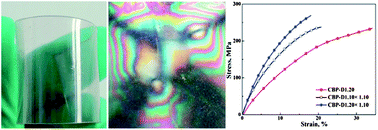A bioplastic with high strength constructed from a cellulose hydrogel by changing the aggregated structure†
Abstract
The direct use of cellulose to fabricate materials such as common plastics as synthetic

Maintenance work is planned from 09:00 BST to 12:00 BST on Saturday 28th September 2024.
During this time the performance of our website may be affected - searches may run slowly, some pages may be temporarily unavailable, and you may be unable to access content. If this happens, please try refreshing your web browser or try waiting two to three minutes before trying again.
We apologise for any inconvenience this might cause and thank you for your patience.
* Corresponding authors
a
Department of Chemistry, Wuhan University, Wuhan 430072, People's Republic of China
E-mail:
jiecaiwhu@hotmail.com, lnzhang@public.wh.hb.cn
Fax: +86-27-6876-2005
Tel: +86-27-8721-6311
b Department of Physics, East China Normal University, Shanghai 200062, People's Republic of China
c State Key Laboratory of Polymer Physics and Chemistry, Institute of Chemistry, Chinese Academy of Sciences, Beijing 100080, People's Republic of China
d Graduate School of Agricultural and Life Sciences, University of Tokyo, Tokyo 113-8657, Japan
e School of Energy and Environment, Southeast University, Nanjing 210096, People's Republic of China
The direct use of cellulose to fabricate materials such as common plastics as synthetic

 Please wait while we load your content...
Something went wrong. Try again?
Please wait while we load your content...
Something went wrong. Try again?
Q. Wang, J. Cai, L. Zhang, M. Xu, H. Cheng, C. C. Han, S. Kuga, J. Xiao and R. Xiao, J. Mater. Chem. A, 2013, 1, 6678 DOI: 10.1039/C3TA11130J
To request permission to reproduce material from this article, please go to the Copyright Clearance Center request page.
If you are an author contributing to an RSC publication, you do not need to request permission provided correct acknowledgement is given.
If you are the author of this article, you do not need to request permission to reproduce figures and diagrams provided correct acknowledgement is given. If you want to reproduce the whole article in a third-party publication (excluding your thesis/dissertation for which permission is not required) please go to the Copyright Clearance Center request page.
Read more about how to correctly acknowledge RSC content.
 Fetching data from CrossRef.
Fetching data from CrossRef.
This may take some time to load.
Loading related content
